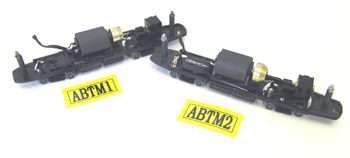Traction modelers must understand how long it takes to get a model into production. This entire project began just before the East Penn Meet in May 2007 when a presentation was made to Bowser by Custom Traxx. The presentation included description of the ex-Philadelphia PCC cars running in San Francisco along with marketing projections on the popularity of the model cars based on the popularity of the prototype cars along with the sales of F-line streetcar related items at various museums and gift shops around the City by the Bay. Plans of the Philadelphia cars as built, as modified in Philadelphia and as modified again by San Francisco had to be obtained and checked. The cars are being produced as placed in service in 1995 because in the thirteen years that they have been in service in San Francisco, more changes have been made.
Using the Bowser PCC shell as a base, the entire PCC model, which is the originally produced Saint Louis Car Company 1945 All-electric PCC with the 20 degree slanted windshield had to be drawn and entered into a 3D computer program. The compound curves of the PCC front end require considerable effort and despite four iterations, as of July 2008, there were still problems as evident in the first shells delivered during the 2008 National Train Show.
These problems are not major, but are complicated by distance and language barriers along with the fact that no one working on this project in China has ever seen these cars or anything similar except in photos provided by us.
These cars are scheduled not only to be sold traditionally as powered model trains but also as unpowered souvenirs in San Francisco and other train museum gift shops. The cars are coming from China in the unpowered form and the power chassis will be made and installed in the USA by Bowser Manufacturing. The excellent Bowser 1999 traction drive must have a flywheel added and a circuit board to make the car DCC ready and to possibly add a decoder and sound in the future. The floor also must be changed along with the mounting hardware to accommodate the new body shell, the new 'snap' fit and the possible future addition of sound.
Concurrent with all of this is the testing of the upgraded Bowser Drive. Custom Traxx has been chosen to oversee the development of the upgraded drive and the Southern California Traction Club is going to perform all extended testing on their test track in Baldwin Hills, CA. Two different flywheel/drive train combinations are being tested at this time. One unit, designated ABTM1, has been installed in a Custom Traxx Kansas City Public Service resin PCC shell, painted as KCPS 584. Unknown to the 2008 National Train Show visitors, this unit was being tested on the module at the Bowser booth during the show. The other unit, ABTM2, has been installed in one of the PCC shells received during the 2008 National Train Show. A third unit, using the first flywheels produced in China, was just receievd and is under testing. One of the just obtained China produced shells is being made into a pre-production model of San Francisco 1052 (Los Angeles Railway), which is ex-Philadelphia 2110. They are being tested with both Bowser and Miniatures by Eric trolley poles, Bowser 12507 contactors and 12502 trolley pole springs. Both cars are equipped with Trains Control Systems M1 DCC decoders and are being tested on both Digitrax and NCE DCC systems and Innovator 3500 DC systems. Minor problems are being corrected as they occur but it appears that the unit will be an enhancement of the current Bowser 125141 mechanism with floor and that the minimum radius will be lowered. How much the operational radius will be lowered is unclear at this time but there will be improvement in that area. Shown below are both cars and two of the three mechanisms currently being tested on one of the modules of the SCTC.
 |
 |